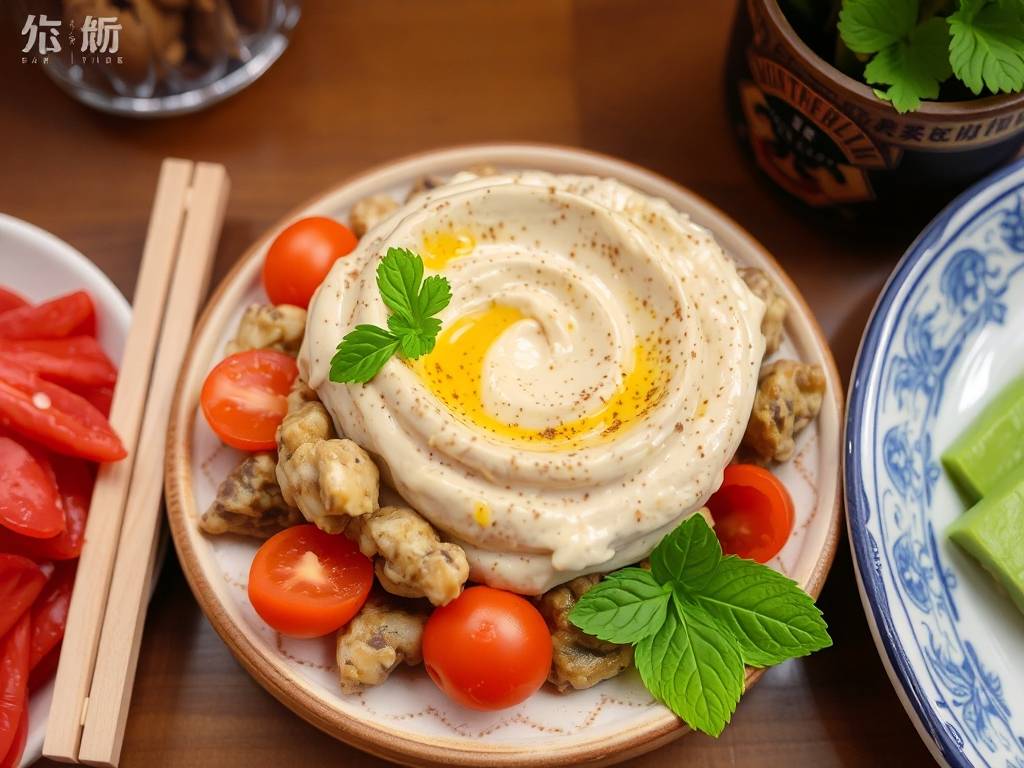The Art of Perfect Hummus: A Guide to Blending Chickpeas & Tahini into Silk
Hummus, that creamy Middle Eastern dip that has conquered global palates, is deceptively simple in its composition yet remarkably complex in its perfect execution. At its core, hummus requires just a handful of ingredients: chickpeas, tahini, lemon juice, garlic, and olive oil. Yet the transformation of these humble components into velvety perfection demands understanding, technique, and respect for the process. This comprehensive guide will walk you through creating sublime hummus that will forever change your relationship with this ancient dish.
The Foundation: Selecting Your Chickpeas
The journey to exceptional hummus begins with the chickpea, also known as garbanzo bean. While canned chickpeas offer convenience, dried chickpeas provide superior texture and flavor that elevates your hummus from good to extraordinary.
For the traditional approach, start with high-quality dried chickpeas. Soak them overnight in plenty of water with a teaspoon of baking soda—this alkaline environment helps break down the chickpea skins, resulting in a creamier final product. The next day, drain and rinse the chickpeas before transferring them to a large pot. Cover with fresh water, add another teaspoon of baking soda, and bring to a boil. Reduce heat and simmer for 1-2 hours until the chickpeas are extremely tender—they should mash easily between your fingers.

The cooking liquid, known as aquafaba, becomes valuable later in the process. Reserve at least a cup of this starchy water before draining your chickpeas. For an even smoother texture, many hummus traditionalists recommend removing the chickpea skins. While tedious, this step eliminates the grainy texture that can plague homemade hummus. Simply rub the cooked chickpeas between your hands or in a kitchen towel—the skins will slip off and can be discarded.
The Soul of Hummus: Tahini Selection and Preparation
Tahini, ground sesame seed paste, provides the distinctive nutty flavor and creamy texture that defines great hummus. Not all tahini is created equal—seek out Middle Eastern brands, which typically have a smoother texture and more complex flavor than many commercial Western versions.
Before using, always stir your tahini thoroughly as the oil naturally separates and rises to the top. The quality of your tahini dramatically affects the final product—look for tahini with a pale color and smooth consistency rather than dark and gritty varieties. For the creamiest results, some experts recommend using tahini at room temperature rather than straight from the refrigerator.
The Alchemy of Blending: Technique Matters
The order in which you add ingredients to your food processor significantly impacts the final texture. Begin with your tahini and freshly squeezed lemon juice—blending these two ingredients first creates an emulsion that forms the foundation of your hummus. Process for a full minute until the mixture lightens in color and becomes fluffy.
Next, add your garlic cloves—adjust quantity based on your preference, but remember raw garlic flavor intensifies over time. Process until the garlic is fully incorporated. Now add your cooked, drained chickpeas. Process for several minutes, scraping down the sides as needed, until the mixture becomes relatively smooth.
Here comes the crucial moment: while the processor is running, slowly drizzle in ice-cold water or your reserved aquafaba. This liquid, added gradually, transforms the mixture from a thick paste into luxuriously smooth hummus. The cold temperature helps maintain a bright flavor and prevents the hummus from becoming gummy.
Continue processing—patience is essential here. Five to seven minutes of processing might seem excessive, but this extended blending time is what creates the impossibly smooth texture that distinguishes professional-quality hummus. The friction from prolonged processing actually helps break down the chickpea particles further than shorter bursts could achieve.
Seasoning and Finishing Touches
Once you've achieved the desired consistency, season with salt to taste. Process briefly to incorporate. Traditional hummus should have a balanced flavor where no single ingredient dominates—the nuttiness of tahini, the brightness of lemon, the pungency of garlic, and the earthiness of chickpeas should harmonize.
To serve, transfer your hummus to a shallow bowl and use the back of a spoon to create swirls on the surface. These grooves will hold your finishing olive oil. Drizzle generously with high-quality extra virgin olive oil—this isn't just garnish but an integral flavor component. Traditional garnishes include paprika, chopped parsley, and whole chickpeas.
Troubleshooting Common Hummus Issues
If your hummus turns out too thick, additional ice water or aquafaba will thin it to your preferred consistency. If it's too thin, you can add more tahini or chickpeas, though this may alter the flavor balance. For grainy hummus, more processing time is usually the solution—the powerful motor of a food processor can achieve smoother results than a blender for this application.
If your hummus tastes bitter, the culprit is often the tahini or garlic. Taste your tahini beforehand—some varieties naturally have a slight bitterness that can be balanced with additional lemon juice. Raw garlic can sometimes impart bitterness; roasting the garlic first creates a sweeter, mellower flavor profile.
Flavor Variations
While classic hummus is perfection itself, variations abound. Roasted red pepper hummus adds sweet, smoky notes. For roasted garlic hummus, bake whole garlic heads until soft and caramelized before adding. Spicy versions might include harissa paste or cayenne pepper. Herb-infused hummus can incorporate parsley, cilantro, or dill. Even dessert hummus versions exist using sweet ingredients like chocolate or vanilla.

Storage and Serving Suggestions
Fresh hummus will keep refrigerated in an airtight container for up to a week. The flavor often improves after a day as the ingredients meld together. If the surface darkens, simply stir it back in. For serving, hummus pairs beautifully with warm pita bread, fresh vegetables, or as part of a mezze platter with olives, feta, and stuffed grape leaves.
Beyond dipping, hummus makes a splendid sandwich spread, a topping for grilled meats or vegetables, or a base for salad dressings when thinned with additional lemon juice and olive oil.
Creating sublime hummus is both science and art—understanding the chemical interactions between ingredients while respecting the traditional techniques that have been perfected over centuries. The transformation of simple chickpeas and tahini into silken perfection through patient blending represents culinary magic accessible to any home cook willing to invest the time and attention. Your perfect hummus awaits—armed with these techniques, you're ready to create a version that might just surpass any you've tasted before.






发表评论